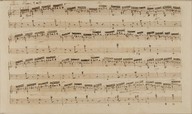



Ap - Presentation autograph
| Date: | XII 1830 - VII 1831 (?) |
| Title: | Etude |
| Dedication: | None |
Fair score of a previous version titled Etude. Very diligently written, with a high number of performance indications (including the metronome mark) and exceptionally, as for Chopin, well marked accidentals, Ap was probably given as a special gift. Its origin – it belonged to famous Viennese researcher and collector of musical treasures Aloys Fuchs – suggests that Chopin could have written and given it during his stay in the city, hence in the first half of 1831. The fact that it displays a previous version is revealed by the following features:
- compliance with CLI in certain details, changed then by Chopin in the final version – lack of differentiating between rhythmic values (crotchets) in the L.H. in bar 4 and analog., more schematic lower voice in the R.H. (double notes instead of single ones) at the beginning of bar 20, 25-26 and 43 and finally in bars 19-23, two strikes of the L.H. in bar 47;
- lack of the lower A1 at the beginning of bars 2, 6 and analog.;
- inconsistent notation of the part of the L.H. (staccato quavers, staccato quavers, crotchets, crotchets).
The attention is drawn by differentiating the sound length of the lower voices in the R.H.:
- sequences of crotchets in bars 1-2, 5-10, 13-15, 36-37 and 40-42;
- semiquavers interchangeably with crotchets in bars 3-4 (11-12, 38-39), 16-23 and 43-44;
- less regular combinations of semiquavers and crotchets in bars 24, 32-35 and 48;
- only semiquavers in bars 25-26, 29-31 and 47;
- three semiquavers and a crotchet in bars 27-28 and 45-46.
Long notes (crotchets) undoubtedly obstruct the performance in this fragment, at the same time weakening the effect of juxtaposing the continuity of the upper voice's line with short, light strikes of the harmonic filling. See the remark concerning bars 1-8.
The slurring is much more abundant than in the version dedicated for publication, particularly in the part of the R.H. In many places it gives, however, an impression of being fragmented. Having to our disposal only a photocopy of deficient resolution of Ap, in case of many places we had doubts concerning the scope of the slurs, as their possible beginnings and endings, delicately tipped with a quill pen, may be imperceptible on the photographs. A similar reservation concerns to a certain extent also dynamic hairpins and accents whose interpretation in this manuscript generally offers a broad range of problems.
The fingering is written in bars 1, 25 and 32-35 and it includes only 20 digits in total. The majority of them are a fragment of fingering which Chopin gave in FEcor, only one note in bar 33 and six last notes in bar 35 have a different fingering.
As a whole Ap includes much more performance indications than the version prepared for publication. It raises the following reflection in terms of mutual relationship between these two versions:
- Version of Ap was performed with a specific person in mind, to whom Chopin gave the autograph, probably displaying a high, professional level of piano skills. Therefore, it would be a notation of a possible interpretation, directed at a particular performer, private and not universal. Hence, the contemporary performers should act with caution in relation to the indications included in Ap.
- Detailed performance indications of Ap could have had a pedagogic value and constituted a sui generis lesson of detailed performance in Chopin's style. The indications, paying particular attention to the plastic performance of the details, may even be considered as an addition, or perhaps even an alternative, to the printed version, however, without losing the easily perceptible mood of the whole.
- Version of Ap reflects a certain stage of shaping of Chopin's vision of the piece. On the other hand, the version prepared for print, even if it includes certain understatements, transfers a generally different concept of the Etude, perhaps taking into account its places compared to other Etudes from the opus.
| Original in: | Stiftelsen Musikkulturens Främjande, the Nydahl Collection, Stockholm |
| Shelf-mark: | MMS 398 |

